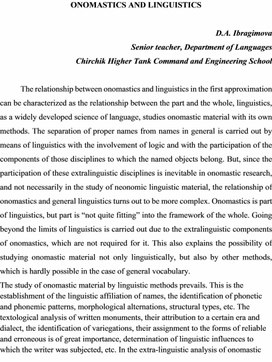ONOMASTICS AND LINGUISTICS
D.A. Ibragimova
Senior teacher, Department of Languages
Chirchik Higher Tank Command and Engineering School
The relationship between onomastics and linguistics in the first approximation can be characterized as the relationship between the part and the whole, linguistics, as a widely developed science of language, studies onomastic material with its own methods. The separation of proper names from names in general is carried out by means of linguistics with the involvement of logic and with the participation of the components of those disciplines to which the named objects belong. But, since the participation of these extralinguistic disciplines is inevitable in onomastic research, and not necessarily in the study of neonomic linguistic material, the relationship of onomastics and general linguistics turns out to be more complex. Onomastics is part of linguistics, but part is “not quite fitting” into the framework of the whole. Going beyond the limits of linguistics is carried out due to the extralinguistic components of onomastics, which are not required for it. This also explains the possibility of studying onomastic material not only linguistically, but also by other methods, which is hardly possible in the case of general vocabulary.
The study of onomastic material by linguistic methods prevails. This is the establishment of the linguistic affiliation of names, the identification of phonetic and phonemic patterns, morphological alternations, structural types, etc. The textological analysis of written monuments, their attribution to a certain era and dialect, the identification of variegations, their assignment to the forms of reliable and erroneous is of great importance, determination of linguistic influences to which the writer was subjected, etc. In the extra-linguistic analysis of onomastic material, one studies the history of the emergence of objects for others, the chronology of geographical discoveries and the movement of tribes and peoples, etc. All these studies, which are basic for historians or geographers, are for onomastics auxiliary, as they help to clarify the reasons for the emergence and change of names, trends in naming and traditions associated with the assignment of names. On the contrary, for historians and geographers, linguistics plays an auxiliary, applied role, helping to extract non-linguistic information from words.
Onomastic research can be carried out in terms of synchronicity and diachrony by structural and comparative - historical methods. Global, areal and regional onomastic studies are possible.
Global onomastics deals with the topological similarity of proper names of different countries and peoples, the establishment of general patterns inherent in names, regardless of their linguistic affiliation, the derivation of onomastic universals, which constitute a well-known parallelism with general linguistic universals.
Areal onomastics establishes the areas of individual onomastic phenomena, which usually do not coincide with dialectological areas, reflecting the linguistic picture that predates the modern one. The areas identified in onomastic studies help to resolve the issue of the substrate, and at the same time, the settlement of peoples in previous eras.
Regional onomastics reveals onomastic systems that combine the names of certain territories. The system affects both the perception of names that already exist and the creation of new ones.
The semiotic nature of onomastic systems of closed collectives connects names as words with a very wide range of social, ideological, biological and other phenomena perceived only by members of these collectives and not always understandable to uninitiated persons. In this respect, proper names are close to terms, and onomastics as a science is close to terminology. Like onomastics, terminology is concerned with a special lexical sector. Like onyms, many terms are actively used only by a narrow circle of specialists, and the establishment of their linguistic status as words is impossible without the participation of specialists from those industries to which these terms relate.
References
1. Березкин Ю. Е. Плеяды – отверстия, Млечный Путь как дорога птиц, девочка на Луне: североевразийские этнокультурные связи в зеркале космонимии // Археология, этнография и антропология Евразии. 2009. Т. 39. №4. С.100–113.
2. Бондалетов В. Д. Русская ономастика. М., 1983.
3. Карпенко Ю. А. Астронимика // Русская ономастика и ономастика России. М. 1994. С. 21–28.
4. Herget, Paul. The Names of the Minor Planets. Cincinnati, 1955–68.
5. Schmadel, Lutz D. Dictionary of Minor Planet Names. 6th ed. Berlin; New York, 2012.
© ООО «Знанио»
С вами с 2009 года.
![]()


